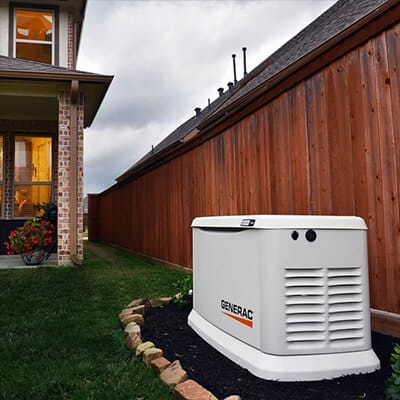How Does A Home Generator Work?

Natural disasters like hurricanes, heavy storms, and earthquakes can cause a power outage, resulting in very frustrating disruptions. Luckily, a generator provides backup power in case of a blackout. It enables you to run essential equipment like the HVAC unit, medical tools, and other household appliances. If you own a generator, it’s a good idea that you understand how it functions. This way, you can notice signs of malfunctions early enough and seek help before the issue gets out of hand.
A generator mainly works by converting mechanical energy into electricity. Once there is a power outage, the generator senses a problem and turns on. It has a copper coil tightly wound onto a metal core that rotates rapidly between horseshoe magnet poles. As the coil turns, it cuts through the magnetic field, interfering with electrons in the conductor, which induces the flow of an electric current.
The generator will continue to run until your utility power gets restored. Here are various parts of the generator that play a role in generating and sending power to your home.
1. Automatic Transfer Switch
The automatic transfer switch connects to your power source, and its primary role is to shift the power load between the generator and utility power grid. A power outage triggers the switch to swap the load connections to the generator. If you have a standby home generator, the controller will flip automatically after a blackout. You will have to flip the switch manually for some older models, however.
The automatic transfer switch isolates your home from the electric utility lines to prevent dangers to utility workers and protect the generator if the utility power returns. When the primary power gets restored, the switch determines if the currents are stable and at acceptable levels and then returns the load from the backup to the primary power source.
2. The Engine
This generator part converts fuel sources into usable energy and is thus the source of mechanical energy. A generator can either use gasoline, propane, natural gas, diesel, or bio-diesel. Note that the power and size of the engine will determine how much electricity the generator produces. If you want a generator with greater output, choose one with a large engine.
3. The Fuel System
Generators have a fuel storage tank with a delivery line that connects to the engine. It also has a return pipe that carries return fuel back to the tank from the engine. You should always ensure that the generator’s lines aren’t kinked or twisted since such restrictions can cause the generator to fail. A fuel pump facilitates the movement of the fuel from the tank to the engine through the pipes.
To support efficient operation, your generator’s fuel tank should have an oil filter that collects any debris present in the oil before delivering it to the engine. Some models also come with a fuel injector that directly pushes the required amount of fuel to the engine’s combustion chamber at higher pressure.
The tank should always store enough fuel to power the generator for the required period. Keep in mind that the size of the fuel tank will determine how long the generator will run. So, if you often rely on your generator for more extended periods, it’s a good idea that you choose a unit with a large enough fuel system.
4. Voltage Regulator and Alternator
An alternator generates the power output through a process involving electromagnetic induction. It contains various components, including the rotor and stator, also referred to as the armature. The rotor is a shaft driven by mechanical energy. It has multiple permanent magnets around it, and it’s usually in constant movement to create a rotating electromagnetic field around the stator.
On the other hand, the stator is a stationary component that contains some conductor coils tightly wound over an iron core. Based on the electromagnetic principle, if a magnetic field moves around a static electric conductor, it results in the production of an electric current. Generally, what happens in this component is that the voltage regulator uses the energy created by the engine to drive the rotor, creating a magnetic field that goes through the stator and, in turn, generates electric currents.
The voltage regulator controls the current power to ensure that it’s suitable for home use. Without this component, the generator can produce unsteady voltage, and you will note massive electricity fluctuations. The voltage regulator allows for smooth and steady operation of all equipment since not all appliances can handle an irregular electricity supply.
5. The Cooling Exhaust and Lubricating System
While in operation, the generator produces a lot of heat, and without the cooling system, it can overheat. A coolant and a fan within the generator help counter the additional heat emitted by the alternator and engine. The coolant absorbs the heat and expels it to the outdoors. Once the power returns and the generator shuts down, the cooling cycle kicks on to lower the temperature of the internal parts.
The engine’s combustion chamber also emits exhaust fumes. The exhaust system thus works to expel the produced gases through a piping system. Note that the generator has various moving parts that require constant lubrication for smooth operation. The lubricating system stores oil and pumps it through the system to protect the components from grinding against each other.
6. The Battery Charger
The generator has a tiny electric motor that kicks it on, and it relies on a battery. Thus, a fully automatic charger supplies a low voltage to the battery to ensure that it’s ready when needed.
7. Control Panel
A generator’s control panel is an interface that works as the brain of the unit. It controls all the parts and indicates helpful information concerning the generator, including the current, voltage, and frequency. Others have inbuilt meters, gauges, and buttons that allow you to operate the generator.
8. Main Assembly Disk
This is the structure that holds the generator’s body in place. For protection, the assembly disk contains all the components of the generator. It can either be in a closed or open design.
Do You Need Professional Assistance With Your Generator?
If you live in areas that experience occasional power blackouts, consider installing a home generator. You need to work with an experienced technician to choose the right system that will best suit your needs. A small-sized generator won’t provide you with enough power. A smaller unit will also strain to meet the power demand, which shortens its lifespan. Worse still, a large generator will cost you too much upfront and use up more fuel, and the high current produced can damage your appliances.
Once you install the system, you will need regular maintenance to ensure that it runs at peak efficiency. It’s important to have a professional routinely lubricate the parts, change the oil filters, check the coolant and fuel level, inspect the control panel, and inspect and replace worn-out parts.
Whenever you need professional assistance with your generator, get in touch with Brennan Electric. We offer whole-house generator services in Seattle, WA, and the nearby areas. Our company also provides lighting installations, smoke and carbon monoxide detectors, electrical repairs, and whole-house surge protection solutions. Reach out to us today and request any of our services.

